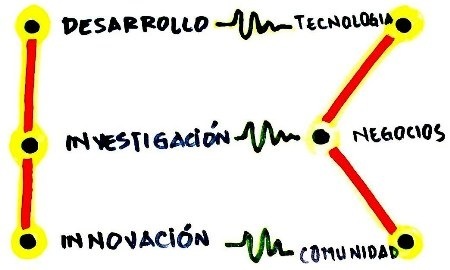 The way free tools have matured is interesting, some years ago, talking about free GIS, sounded like UNIX, in a geek voice and with a level of distrust or fear of the unknown. All that has changed much with the diversity of solutions that have full-grown not only in the construction of routines commonly expected but overcrowding innovative strategies, testing and adaptation to the collective intelligence based on the exchange. The OSGeo and OGC standards are the result of that maturity.
The way free tools have matured is interesting, some years ago, talking about free GIS, sounded like UNIX, in a geek voice and with a level of distrust or fear of the unknown. All that has changed much with the diversity of solutions that have full-grown not only in the construction of routines commonly expected but overcrowding innovative strategies, testing and adaptation to the collective intelligence based on the exchange. The OSGeo and OGC standards are the result of that maturity.
It happens now that with trust we can recommend open source solutions that are efficient (QGIS and gvSIG to take two examples), there is a diversity to choose from, but we also know that in a few years, many will be discontinued or merged under the shadow of the most sustainable (eg cases of Qgis +Grass and gvSIG + Sextant). The topic about who will survive should be seriously considered today, because loyalty has its limits, the sustainability of GIS software under open source method is based on pillars such as technology, business and community.

Technological sustainability somehow is controllable, or at least it seems that we are not already scared with its crazy rhythm of making obsolete a development every 5 minutes. But we have learned to understand, that this is also a way to clean up the stage and that the applications with sustainability problems get out of the way, although it is painful for the faithful. For example Ilwis, with all its merits, has difficulties to get out of Visual Basic 6.
Financial sustainability, or what we call business, surprisingly has walked. There are now many projects which are sustained by purely voluntarism, through foundations, projects formally constituted or even simple buttons that applies “collaborate via PayPal”. At this level is quite admirable the gvSIG case, as part of a big migration project to free software, has a well-planned financial sustainability.
But the sustainability of the community seems to be the axis of more complex control, because not only depends on the “creator” but because it has great influence on the technological field (both ways), and can make it difficult to handle the financial issue. Financial and technological experts are trained by the Academy, and are science if not exact, theoretically defined. The concept of “this type of community” emerges from the overcrowding of the Internet and the consolidation of trends that have evolved naturally as result “of the community”; so the shaft is interdisciplinary, among communication, education, marketing, technology and everything with a dressing of social psychology.
My respects for those who are behind this line, with projects such as gvSIG, whose expectations of internationalization are very aggressive. I must admit that is one of the projects for which I keep my most sincere admiration (aside from the hazards of this job), I believe they have achieved a lot not only in the Hispanic environment (which in itself is complicated.)
One line of this route (and the only one I’ll talk about today) is the theme of “user loyalty” through mutual exchange of information. Measure this must be very complicated, so I’m going to be based on an exercise more absurd than simple:
-The Wikipedia is powered by the community.
– The faithful user to software, who likes to communicate, he writes about it.
-In the community environment, all faithful users to that software will contribute to it on Wikipedia.
It is absurd, I know, but I want to put it as an example, because even although the Wikipedia is much criticized by academics as a reliable source, its content every day becomes the first reference and plays an important role in the user-search- content relation.
Then, I used as starting point the page “GIS”, then I went to each of the pages of 11 programs and counted the number of words that occur there, since the subject to the reference category.
In totaling nearly 5,000 words, the result is as follows:
| GvSIG + Sextant | 1,022 | 21% |
| Local GIS | 632 | 13% |
| Geopista | 631 | 13% |
| Qgis + Grass | 610 | 12% |
| Jump | 485 | 10% |
| Ilwis | 468 | 10% |
| Kosmo | 285 | 6% |
| Capaware | 276 | 6% |
| Generic Mapping Tools | 191 | 4% |
| MapGuide Open Source | 172 | 3% |
| SAGA GIS | 148 | 3% |
| Total | 4,920 |
Note that the sum of gvSIG + Sextant take 21%, it is not surprising if we remember that these have been projects that have spent much time to the organized documentation of information on their official website, have invested in process systematizing, manuals, user lists and many other efforts for internationalization.
We can also see that QGis + Grass are left behind; its strongest dissemination is not exactly in the Hispanic environment, although Grass is perhaps the oldest GIS Open Source still alive.
This is only the subject of loyalty based on reciprocity, and only seeing the Wikipedia as an example. As we can see with satisfaction, gvSIG + Sextant have an important influence on the Hispanic environment. We would possibly see similar behavior in social networks, blogs, computer magazines and forums, although, of course, this leads to a greater degree of liability by the community.
But the fact that “our hazards” lead us to question aspects of communication, it does not attempt to suggest that we are experts in the sustainability topic. It’s part of being “community”; these are common reactions from those like us that expect with much faith in projects of this size (although, I admit, it does not justify the tone).
Possibly it is necessary to pay attention to the dissemination of information, which is filtered by different channels that promote the initiative (as in the case of Geomática Libre in Venezuela) or informal communications in distribution lists become unofficial truths and that create expectations. This and more nitpick fixes through institutional communication, which we must recognize the “community channel” both for and against, to secure part of the sustainability.
It is appropriate to review the community reacts to webcasting, because community is a living element, behaves like the people reacts, thinks, feels, speaks, writes, complains, is pleased, and especially has expectations in the project. An example of how it is created an expectation:
-What’s worth in gvSIG 1.3, that we had seen in gvSIG 1.9
-What’s worth on gvSIG 1.9: what is unstable
-What’s worth that is unstable: that we don’t know when it will be
-Moment: It seems later will be.
-When will it be…?
It is necessary to review the issue of community in a project so big, with an international, multicultural scope. Constant officially communication is never over, if it contributes to the sustainability of the community.
Finally I should have deleted the original post that has moved me to touch the topic, once the patches have been almost impossible and the new thread is incompatible with the worn cloth.
 Autocad Software, Bentley Microstation, Gis Google Earth, Gis System Geomate Provides Services For Complete Gis Software And Solutions, Autocad Software, Autocad Courses, Bentley Microstation, Microstation Software, Gis Google Earth, Open Source Gis And More.
Autocad Software, Bentley Microstation, Gis Google Earth, Gis System Geomate Provides Services For Complete Gis Software And Solutions, Autocad Software, Autocad Courses, Bentley Microstation, Microstation Software, Gis Google Earth, Open Source Gis And More.